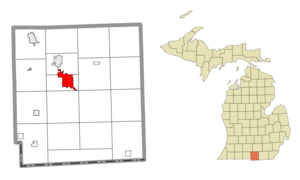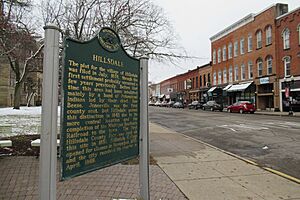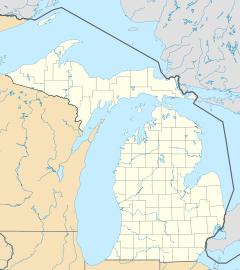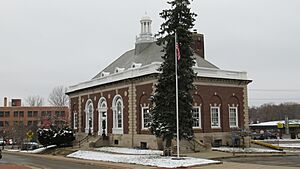Hillsdale, Michigan facts for kids
Quick facts for kids
Hillsdale, Michigan
|
|
|---|---|
| City of Hillsdale | |

Hillsdale Downtown Historic District
|
|

Location within Hillsdale County
|
|
| Country | United States |
| State | Michigan |
| County | Hillsdale |
| Settled | 1834 |
| Incorporated | 1847 (village) 1869 (city) |
| Government | |
| • Type | Council–manager |
| Area | |
| • Total | 6.13 sq mi (15.88 km2) |
| • Land | 5.69 sq mi (14.74 km2) |
| • Water | 0.43 sq mi (1.11 km2) |
| Elevation | 1,119 ft (341 m) |
| Population
(2020)
|
|
| • Total | 8,036 |
| • Density | 1,412.30/sq mi (545.29/km2) |
| Time zone | UTC-5 (Eastern (EST)) |
| • Summer (DST) | UTC-4 (EDT) |
| ZIP code(s) |
49242
|
| Area code(s) | 517 |
| FIPS code | 26-38460 |
| GNIS feature ID | 0628321 |
Hillsdale is a city in the state of Michigan, United States. It is the largest city and the main town (called the county seat) in Hillsdale County.
In 2020, about 8,036 people lived in Hillsdale. The city is also home to Hillsdale College, which is a private college.
Contents
History of Hillsdale

Hillsdale is located in the rolling hills of South Central Michigan. This area is close to the borders of Indiana and Ohio. For a long time, the land was home to the Potawatomi people. They spoke an Algonquian language and were part of a group called the Council of Three Fires. This group included the Ojibwe and Odawa (Ottawa) tribes.
A group of about 150 Potawatomi, led by Chief Baw Beese, had a main camp near a large lake in the area.
Early Settlers and Town Growth
The first European-American settler, Jeremiah Arnold, arrived in 1834. He met the Potawatomi people, who helped the early settlers. Arnold built a cabin and moved in with his wife, Percy. As more settlers came, they built the first schoolhouse in 1838. Hillsdale was officially planned out in 1839.
In 1840, the U.S. government made Chief Baw Beese and his people leave the area. Other Potawatomi groups from Michigan, Indiana, and Ohio also had to move. They were sent to Indian Territory, which is now Kansas.
Hillsdale College and Railroad Era
Hillsdale College was first started in 1844 as Central Michigan College. It was located in Spring Arbor. In 1853, the college moved to Hillsdale and changed its name. It was very important because it was the first college in America to say that it would not treat people differently based on their race, religion, or gender. It also became a strong supporter of ending slavery. It was the second college in the country to give four-year degrees to women.
Hillsdale officially became a city in 1869. In 1885, the city opened its first high school building. This building is now used as the middle school. In the late 1800s, Hillsdale became a busy railroad town. Both freight (goods) and passenger trains used the tracks.
The railroad also brought tourists to Baw Beese Lake. This lake was named after the Potawatomi chief. The Lake Shore and Michigan Southern Railroad developed the area as a lake resort. People could take the train to avoid dusty roads. Around 1900, tourists from cities like Chicago and Toledo came to the lake. They enjoyed swimming and renting canoes.
Modern Developments
After World War II, more people started using cars because new highways were built. This meant fewer people took trains. The last passenger train left Hillsdale in 1956. Many beautiful Victorian homes were built in the 1800s. Many of these homes are still used today, adding to the city's history.
The 20th century brought more improvements. In 1908, the city opened its first public library. In 1921, it opened its first hospital. The Hillsdale Municipal Airport opened in 1934.
Geography of Hillsdale
Hillsdale covers about 6.13 square miles (15.88 square kilometers). Most of this area is land, and a small part is water.
The St. Joseph River starts in Hillsdale. It flows from Lake Baw Beese. There are several parks and a beach around Lake Baw Beese in the city.
Hillsdale's Climate
Hillsdale has a climate with big changes in temperature throughout the year. Summers are warm to hot, and winters are cold. This type of climate is called a humid continental climate.
| Climate data for Hillsdale, Michigan (1991–2020 normals, extremes 1891–present) | |||||||||||||
|---|---|---|---|---|---|---|---|---|---|---|---|---|---|
| Month | Jan | Feb | Mar | Apr | May | Jun | Jul | Aug | Sep | Oct | Nov | Dec | Year |
| Record high °F (°C) | 67 (19) |
69 (21) |
86 (30) |
88 (31) |
94 (34) |
104 (40) |
107 (42) |
104 (40) |
98 (37) |
91 (33) |
79 (26) |
69 (21) |
107 (42) |
| Mean daily maximum °F (°C) | 30.6 (−0.8) |
33.9 (1.1) |
44.3 (6.8) |
57.7 (14.3) |
69.3 (20.7) |
78.5 (25.8) |
82.5 (28.1) |
80.1 (26.7) |
73.9 (23.3) |
61.1 (16.2) |
47.2 (8.4) |
35.7 (2.1) |
57.9 (14.4) |
| Daily mean °F (°C) | 22.8 (−5.1) |
25.1 (−3.8) |
34.4 (1.3) |
46.3 (7.9) |
58.1 (14.5) |
67.5 (19.7) |
71.2 (21.8) |
69.2 (20.7) |
62.1 (16.7) |
50.4 (10.2) |
38.7 (3.7) |
28.7 (−1.8) |
47.9 (8.8) |
| Mean daily minimum °F (°C) | 15.1 (−9.4) |
16.4 (−8.7) |
24.5 (−4.2) |
35.0 (1.7) |
46.8 (8.2) |
56.5 (13.6) |
59.9 (15.5) |
58.3 (14.6) |
50.3 (10.2) |
39.6 (4.2) |
30.1 (−1.1) |
21.8 (−5.7) |
37.9 (3.3) |
| Record low °F (°C) | −22 (−30) |
−21 (−29) |
−15 (−26) |
3 (−16) |
16 (−9) |
31 (−1) |
36 (2) |
34 (1) |
26 (−3) |
15 (−9) |
−4 (−20) |
−19 (−28) |
−22 (−30) |
| Average precipitation inches (mm) | 2.77 (70) |
2.25 (57) |
2.40 (61) |
3.68 (93) |
4.56 (116) |
3.91 (99) |
3.62 (92) |
3.93 (100) |
3.58 (91) |
3.43 (87) |
2.97 (75) |
2.44 (62) |
39.54 (1,004) |
| Average snowfall inches (cm) | 13.3 (34) |
11.5 (29) |
5.2 (13) |
1.5 (3.8) |
0.0 (0.0) |
0.0 (0.0) |
0.0 (0.0) |
0.0 (0.0) |
0.0 (0.0) |
0.1 (0.25) |
3.4 (8.6) |
9.1 (23) |
44.1 (112) |
| Average precipitation days (≥ 0.01 in) | 14.7 | 11.6 | 11.3 | 14.0 | 13.7 | 11.7 | 10.1 | 11.1 | 10.4 | 12.8 | 12.5 | 13.7 | 147.6 |
| Average snowy days (≥ 0.1 in) | 10.5 | 8.3 | 4.3 | 1.0 | 0.0 | 0.0 | 0.0 | 0.0 | 0.0 | 0.1 | 2.9 | 7.8 | 34.9 |
| Source: NOAA | |||||||||||||
Hillsdale's Population and People
| Historical population | |||
|---|---|---|---|
| Census | Pop. | %± | |
| 1850 | 1,067 | — | |
| 1860 | 2,177 | 104.0% | |
| 1870 | 3,518 | 61.6% | |
| 1880 | 3,441 | −2.2% | |
| 1890 | 3,915 | 13.8% | |
| 1900 | 4,151 | 6.0% | |
| 1910 | 5,001 | 20.5% | |
| 1920 | 5,476 | 9.5% | |
| 1930 | 5,896 | 7.7% | |
| 1940 | 6,381 | 8.2% | |
| 1950 | 7,297 | 14.4% | |
| 1960 | 7,629 | 4.5% | |
| 1970 | 7,728 | 1.3% | |
| 1980 | 7,432 | −3.8% | |
| 1990 | 8,170 | 9.9% | |
| 2000 | 8,233 | 0.8% | |
| 2010 | 8,305 | 0.9% | |
| 2020 | 8,036 | −3.2% | |
| U.S. Decennial Census | |||
In 2010, there were 8,305 people living in Hillsdale. About 95.8% of the people were White. Other groups included African American, Native American, and Asian people. About 2.3% of the population was Hispanic or Latino.
Many different types of households live in Hillsdale. About 31% of homes had children under 18. The average age of people in the city was about 30 years old.
Education in Hillsdale
The Hillsdale Community School District serves the city. It includes Hillsdale High School, Davis Middle School, and two elementary schools.
There are also private and charter schools in Hillsdale. These include Hillsdale Academy, Will Carleton Academy, and Hillsdale Preparatory School. As mentioned, Hillsdale College is also in the city.
Discussion at the Hillsdale Library
In 2022, the Hillsdale Library Board had a discussion about some books. A board member suggested removing certain books and puzzles from the children's section. This discussion caused some disagreement. The proposed removal of books did not happen. However, the event led to the library director, the children's library director, and the library board president leaving their jobs.
Transportation in Hillsdale
Major Roads
- US 12 passes about 2 miles (3.2 km) north of Hillsdale.
- M-99 runs through the center of the city.
Air Travel
- Hillsdale Municipal Airport is a public airport. It is located just east of the city in Adams Township.
Railroads
- The Indiana Northeastern Railroad has a railway line that goes through Hillsdale.
Media in Hillsdale
Radio Stations
- WCSR/1340 kHz (AM radio)
- WPCJ/91.1 MHz (FM radio)
- WCSR-FM/92.1 MHz (FM radio)
- WRFH-LP/101.7 MHz (FM radio)
Newspapers
- Hillsdale Daily News
- Imprimis, a monthly speech digest from Hillsdale College
- The Collegian, the student newspaper for Hillsdale College
Notable People from Hillsdale
- Lee Bartlett, an Olympic athlete
- Baw Beese, a Potawatomi chief
- Will Carleton (1845–1912), a poet and newspaper reporter
- William W. Cook, a legal scholar
- Charles Doolittle, a Civil War general
- Sile Doty, a famous thief
- Dick Estell, host of The Radio Reader
- Andrew Fink, a Michigan State Legislature member
- Caril Ann Fugate, known for a historical legal case
- Henry Churchill King, a theologian and college president
- Penny Neer, an Olympic athlete
- John Corbett O'Meara, a United States District Court judge
- Jason Robards Sr., an actor
- Michael Sessions, one of the youngest mayors ever elected
- Rube Vickers, a Major League baseball pitcher
- Henry Waldron, a politician
- Frank "Muddy" Waters, a Hall of Fame football coach
See also
 In Spanish: Hillsdale (Míchigan) para niños
In Spanish: Hillsdale (Míchigan) para niños





